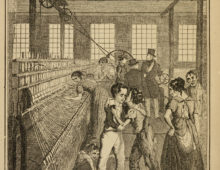Tagged with Duke of Wellington
Resource : A pair of ‘Wellington boots’
These are the original ‘Wellington boots’, designed for the Duke of Wellington to be both practical and fashionable. They were adapted from the ‘Hessian’ boots previously worn by British officers to allow the wearing of new lightweight linen trousers rather than traditional woollen ones. They were cut lower to make riding more comfortable, and no longer had a tassel. After the Duke’s victory at Waterloo, this style of boot became extremely fashionable and spread through London society, eventually inspiring the modern ‘welly’.
Resource : Speech of Thomas Attwood, Printed on Silk
This piece of silk commemorates Thomas Attwood receiving the freedom of the City of London, following his role in the Great Reform Act of 1832. The Act granted more people in Britain the right to vote and created seats for MPs in new industrial towns like Birmingham and Manchester. The words of Attwood’s speech are contained within the letters of his name and title.
Resource : Train ticket: Liverpool to Warrington
The advent of steam hauled railways in the 1820s quickly revolutionised passenger travel and the transport of goods across Britain and the wider world. This is an early train ticket for a journey from Liverpool to Warrington.
Resource : Passport Signed by the Duke of Wellington
Travelling in Europe was very popular among the British nobility, gentry, and professionals of the 1700s and 1800s. It became traditional for upper class men and women to embark on a lengthy ‘Grand Tour’ of Europe, where they would experience the languages and history of the continent while showing off their own status and wealth. It was also popular with British artists, writers and thinkers of the time, keen to broaden their experience and exchange ideas – particularly with their counterparts and the new celebrities and centres thrown up by the upheavals of revolution.
Resource : Marengo’s trotters reunited
February 11, 2017 - The Chairman
Recently Christopher Joll, late of The Life Guards, managed to photograph together the two front hooves of Marengo. Both are featured in our 200 objects but they are not together. See http://ageofrevolution.org/200-object/marengos-hoof-snuffbox/ and http://ageofrevolution.org/200-object/horses-hoof-snuff-mill/ The photograph shows the hooves and are in size and shape identical although the colour is different, which is normal particularly as […]


